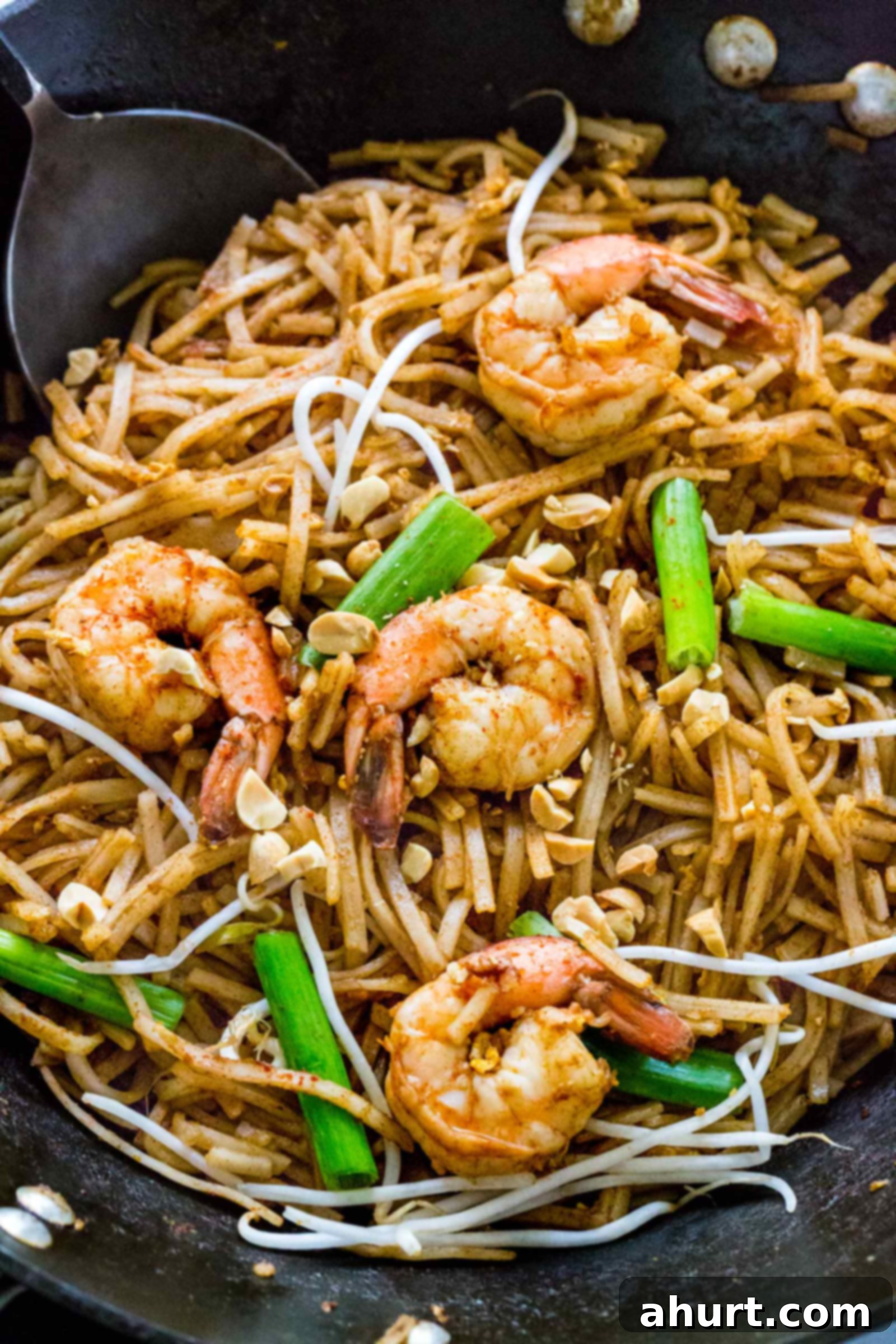Authentic Chicken and Shrimp Pad Thai Recipe: Quick, Easy & Bursting with Thai Flavors
Pad Thai is more than just a dish; it’s a culinary journey, a symphony of flavors that has captivated palates worldwide. This ultimate quick and satisfying stir-fry is a weekday dinner dream, promising a delicious, restaurant-quality meal ready in under 30 minutes! Our classic Thai noodle dish showcases tender rice noodles perfectly tossed with juicy chicken, succulent shrimp, and an irresistible homemade Pad Thai sauce that beautifully hits all the essential sweet, tangy, savory, and subtly spicy notes.
If you’ve ever dreamt of recreating that magical Pad Thai experience at home but felt intimidated, this is your moment. Crafting authentic Pad Thai noodles from scratch is far easier than you might imagine. The bold, vibrant, and utterly irresistible flavors you’ll achieve will undoubtedly elevate this recipe to your new favorite go-to weeknight dinner, proving that exceptional Thai cuisine is well within your reach.
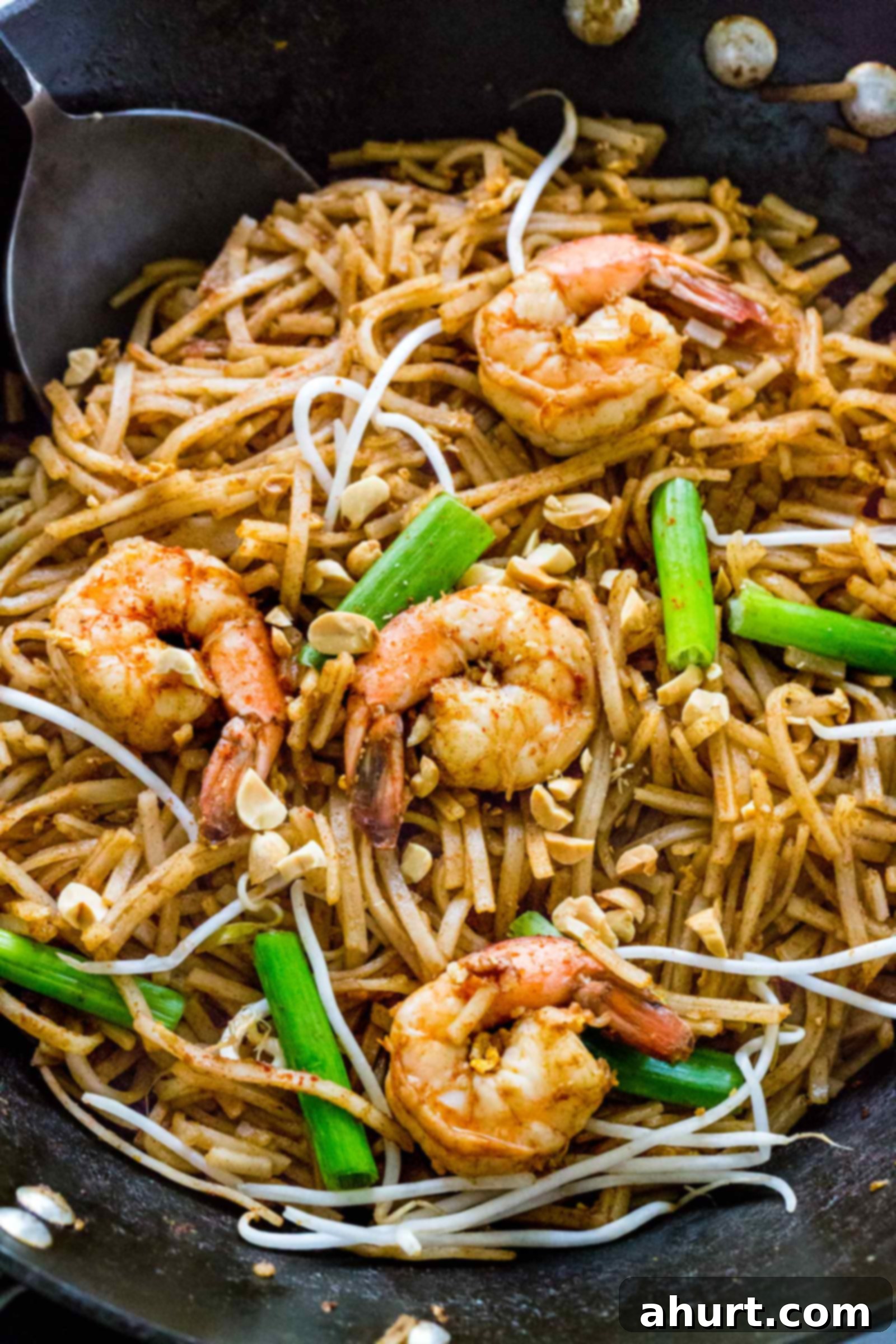
What Makes Our Pad Thai Recipe Stand Out
This Pad Thai recipe isn’t just good; it’s truly exceptional, hitting every right note that defines authentic Thai cuisine. We’ve perfected the delicate balance of flavors: the perfect sweetness, the undeniable saltiness, a refreshing tang, and just a hint of heat. The secret lies in our rich, homemade Pad Thai sauce, meticulously crafted with tamarind, premium fish sauce, a touch of brown sugar, and a whisper of chili. This luscious sauce adheres beautifully to every single noodle, ensuring a flavor explosion in every bite.
Beyond the exquisite taste, what truly sets this Pad Thai recipe apart is its captivating mix of textures. Imagine the satisfying chewiness of perfectly cooked rice noodles, intertwined with the tender juiciness of chicken, the succulent bite of shrimp, the delightful crunch of roasted peanuts, and the fresh zest of green onions and bean sprouts. Each forkful is a harmonious blend that creates an unforgettable culinary experience. It’s incredibly quick to prepare, bursting with authentic flavors, and tastes even better than your favorite Thai takeout.
Pad Thai’s origin story traces back to Thailand in the 1930s and 40s, when the government promoted it as a national dish to foster patriotism and use locally available ingredients. It quickly became a staple, beloved for its complex flavor profile and accessibility. Our recipe honors this tradition while making it achievable in your own kitchen.
The Essential Ingredients for Perfect Pad Thai
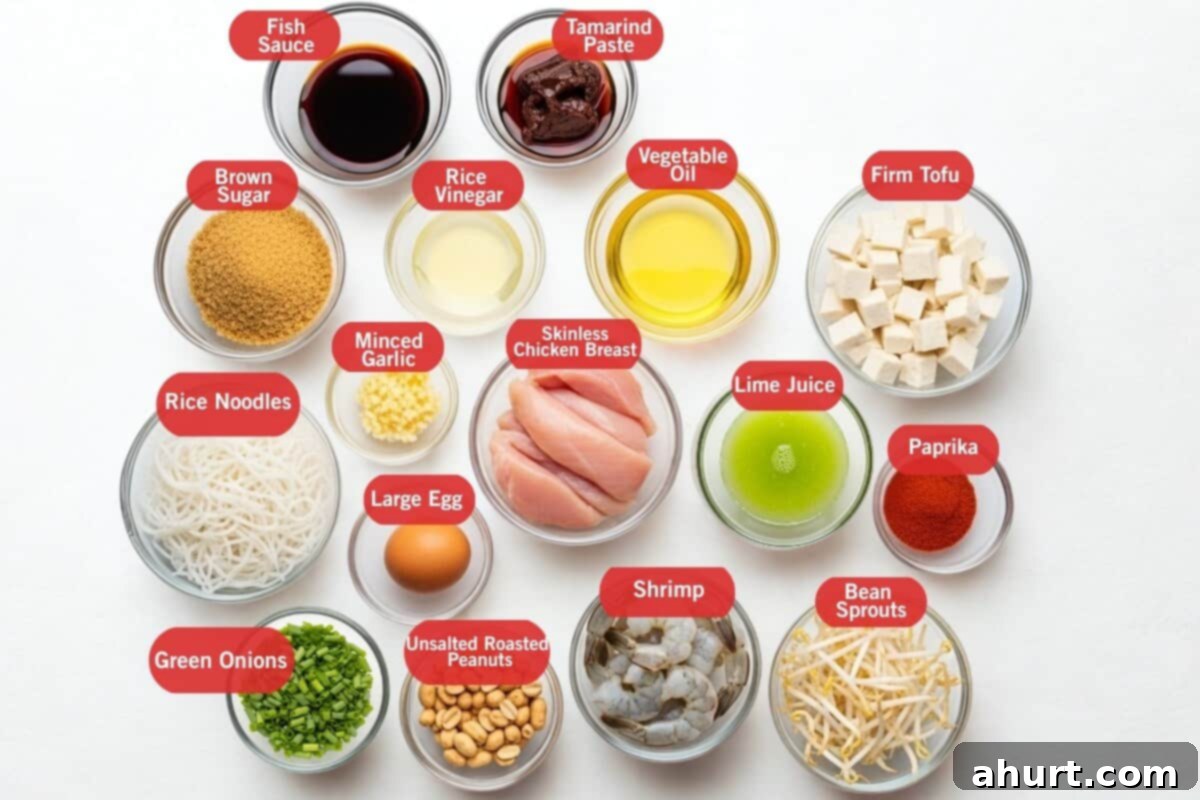
This Pad Thai recipe bursts with bold flavors and fresh textures, all thanks to a carefully balanced homemade sauce and a delightful mix of proteins and vegetables. You’ll be amazed at how effortlessly everything comes together in one sizzling pan, transforming simple ingredients into a gourmet experience.
- Dried Rice Noodles: These are the undisputed foundation of any authentic Pad Thai. Opt for medium-width flat rice noodles, often labeled specifically as “Pad Thai noodles.” Their chewy texture is perfect for absorbing every drop of the sweet, tangy, and savory sauce without becoming mushy.
- Tamarind Paste: This is the secret ingredient for that signature tangy kick, essential for authentic Thai flavor. Tamarind paste provides a unique sourness that can’t be replicated, giving Pad Thai its distinctive zest.
- Fish Sauce: The backbone of savory Thai cuisine, fish sauce adds a profound depth of umami and saltiness. Don’t be deterred by its strong aroma; it transforms into a rich, complex flavor when cooked.
- Brown Sugar: To balance the tang of tamarind and the saltiness of fish sauce, brown sugar provides the crucial sweetness, contributing to the dish’s irresistible caramelization and glaze.
- Lime Juice: Fresh lime juice brightens the entire dish, adding a zesty, aromatic finish that cuts through the richness and enhances all other flavors. Always use freshly squeezed for the best results.
- Chicken and Shrimp: A classic and popular protein combination that makes this dish incredibly hearty and satisfying. Using both chicken and shrimp ensures maximum flavor complexity and a delightful variety of textures in every bite. For chicken, boneless, skinless breasts or thighs sliced thinly work best. For shrimp, opt for large, peeled, and deveined varieties for quick cooking.
- Firm Tofu & Egg: Tofu adds a lovely texture and absorbs flavor beautifully, while scrambled egg is a traditional component that brings richness and binds the elements together.
- Bean Sprouts: Added at the very end, bean sprouts provide a refreshing, crisp crunch that perfectly balances the richness of the sauce and proteins.
- Green Onions & Peanuts: Green onions contribute a mild, fresh oniony bite, and chopped roasted peanuts are a non-negotiable garnish, offering a fantastic nutty crunch and flavor.
- Garlic & Paprika: Minced garlic forms an aromatic base, while paprika contributes a subtle warmth and a beautiful reddish hue, which is often characteristic of Pad Thai.
Note: Please see the recipe card below for a complete list of ingredients with precise measurements.
Mastering Your Homemade Pad Thai: A Step-by-Step Guide
Making Pad Thai at home is an exciting and rewarding experience. Follow these simple steps to create a dish that’s bursting with authentic Thai flavors and textures. The key is preparation and working quickly once the stir-frying begins!
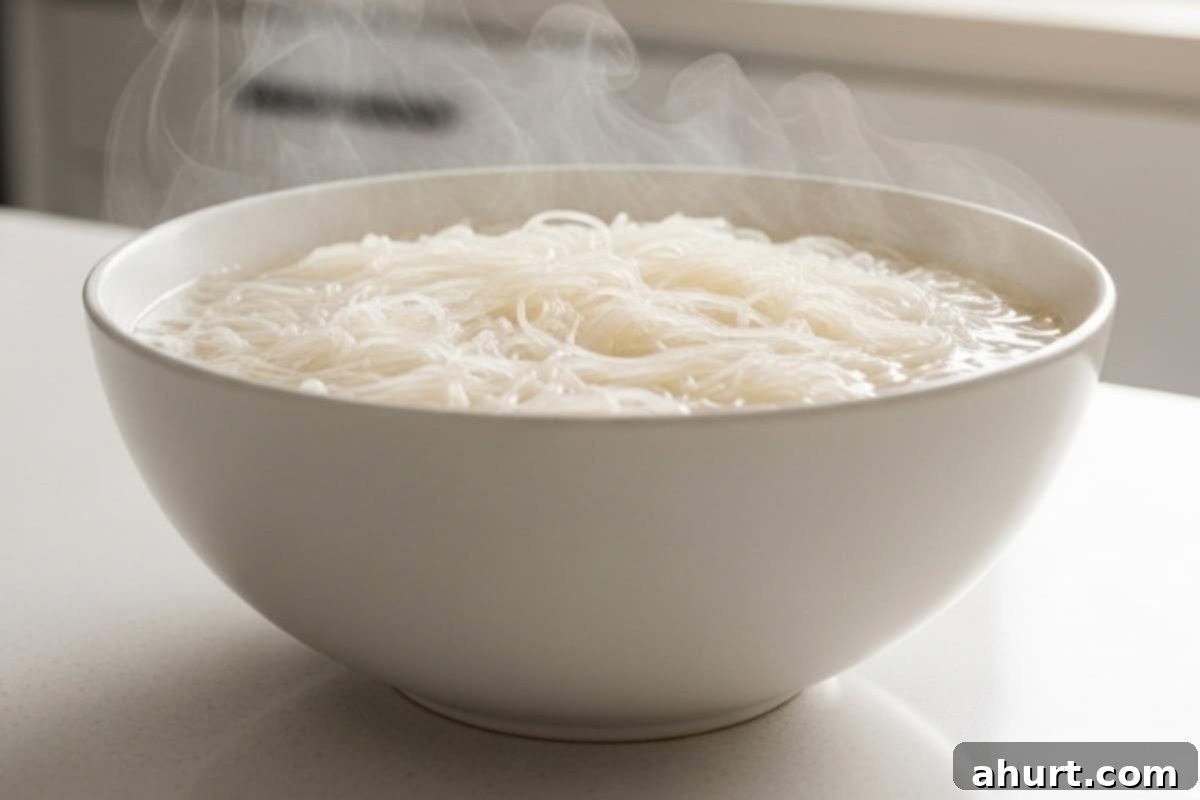
- Soak the Noodles: Begin by placing your dried rice noodles in a large bowl. Cover them generously with hot (but not boiling) water. Let them soak for approximately 5 to 10 minutes, or until they are flexible and pliable but still firm to the bite – you don’t want them completely soft or mushy, as they’ll continue cooking in the wok. Once perfectly al dente, drain them thoroughly and rinse with cold water to prevent further cooking and sticking. Set aside.
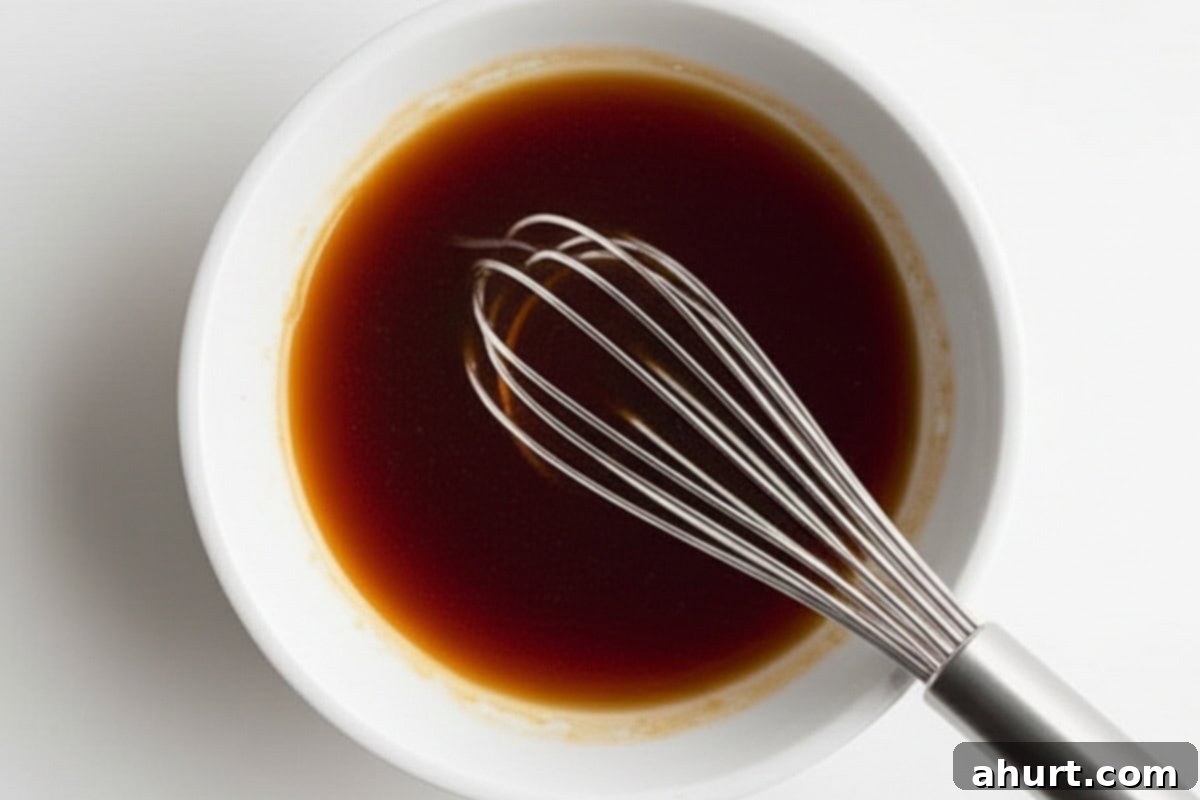
- Prepare the Signature Sauce: In a small bowl, whisk together the fish sauce, brown sugar, tamarind paste, fresh lime juice, and rice vinegar until the sugar is fully dissolved and the mixture is smooth. This perfectly balanced sauce is the heart of your Pad Thai, so take a moment to taste and adjust if you like more sweetness or tang. Set this flavorful sauce aside to allow the ingredients to meld while you prepare the other components.
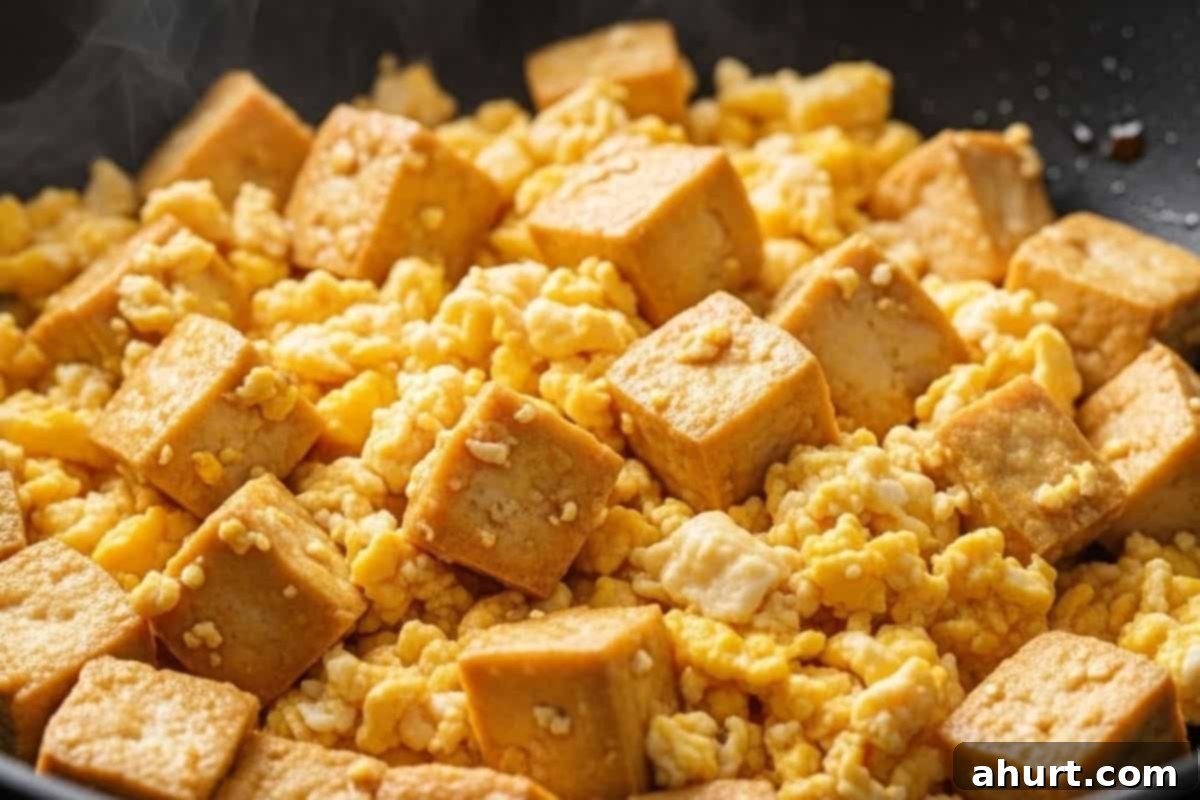
- Cook the Tofu and Egg: Heat 1 tablespoon of vegetable oil in a large wok or a heavy-bottomed skillet over medium-high heat until shimmering. Add the diced firm tofu and stir-fry for 1-2 minutes until it’s golden and lightly crispy on all sides. Push the cooked tofu to one side of the wok. Crack the large egg directly into the empty space and quickly scramble it with your spatula until just set but still slightly soft. Immediately incorporate the tofu into the egg.
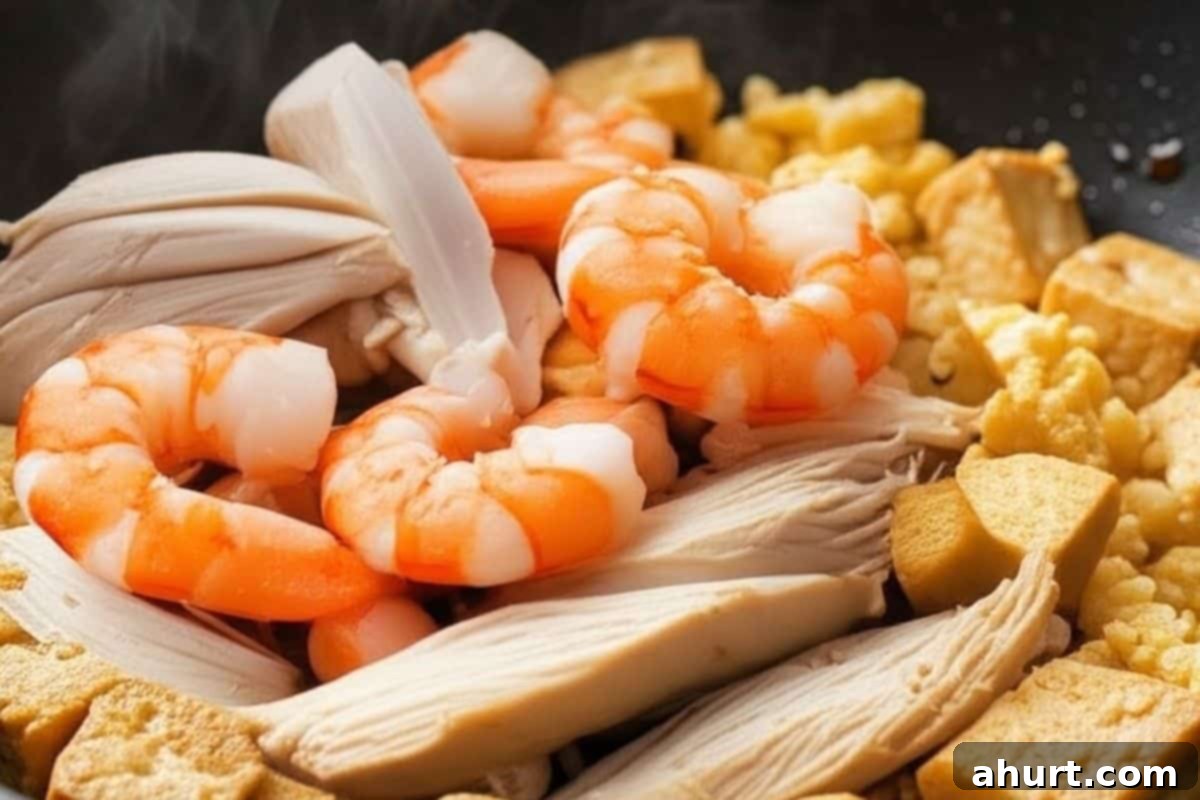
- Introduce Chicken and Shrimp: Add the thinly sliced boneless, skinless chicken breasts to the pan. Stir-fry for 2 to 3 minutes, or until the chicken is no longer pink and is cooked through. Next, add the peeled and deveined shrimp. Cook for another 1 to 2 minutes, just until they turn a beautiful pink and become opaque. Be careful not to overcook the shrimp, as it can become rubbery. Transfer the cooked chicken, shrimp, tofu, and egg mixture to a separate plate and set aside for a moment.
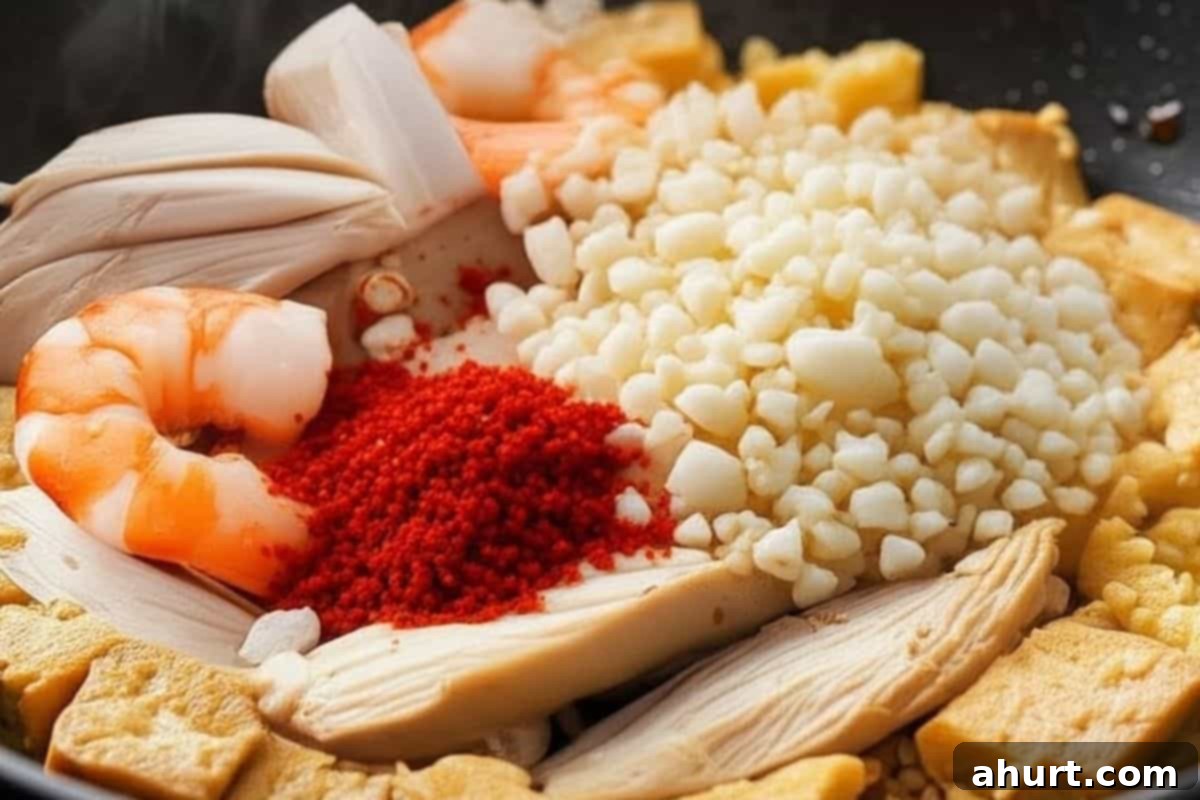
- Stir in Aromatics: Add the remaining 1 tablespoon of oil to the now empty (or mostly empty) wok. Once hot, add the minced garlic and paprika. Stir-fry for a quick 30 seconds until fragrant, being extremely careful not to burn the garlic, as burnt garlic can impart a bitter taste. This step builds the aromatic foundation for the noodles.
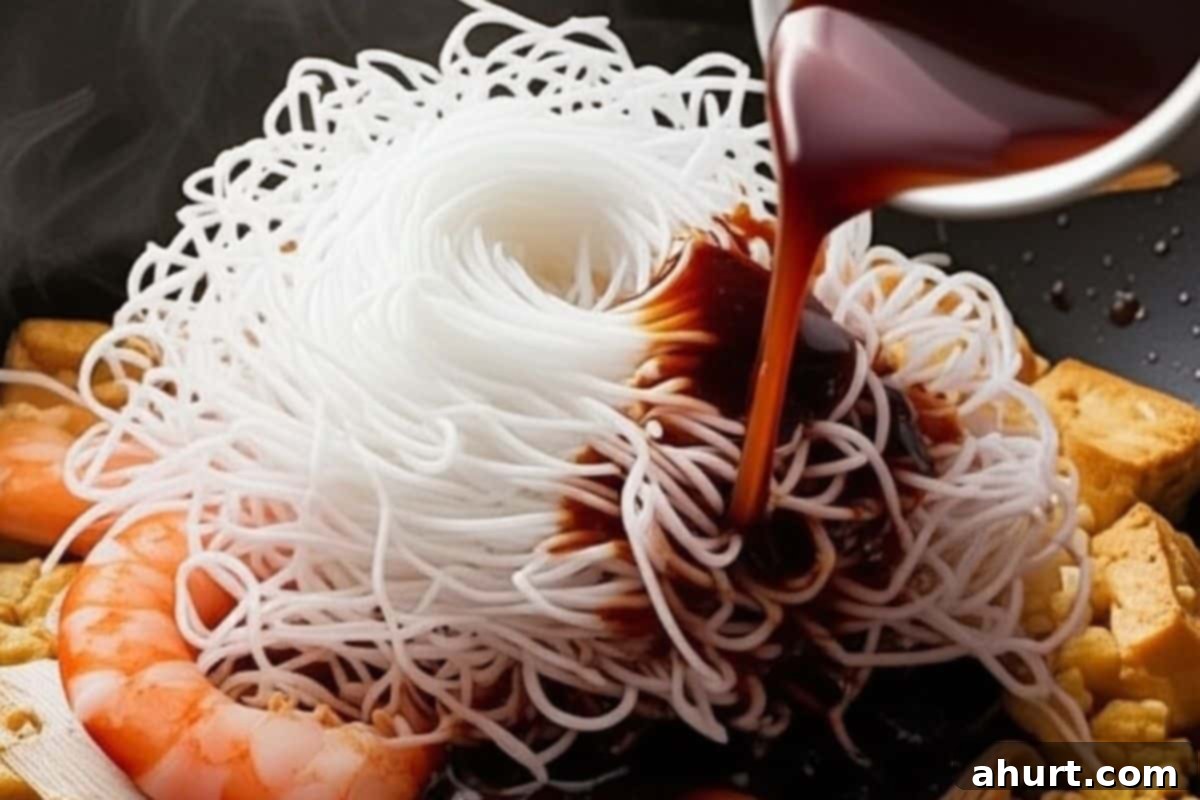
- Toss in the Noodles & Sauce: Quickly add the drained, pre-soaked noodles back into the wok with the aromatics. Pour the prepared Pad Thai sauce evenly over the noodles. Using tongs or two spatulas, toss everything together vigorously to ensure every strand of noodle is beautifully coated in the rich, flavorful sauce. Continue to stir-fry for 1-2 minutes, allowing the noodles to absorb the sauce and heat through.
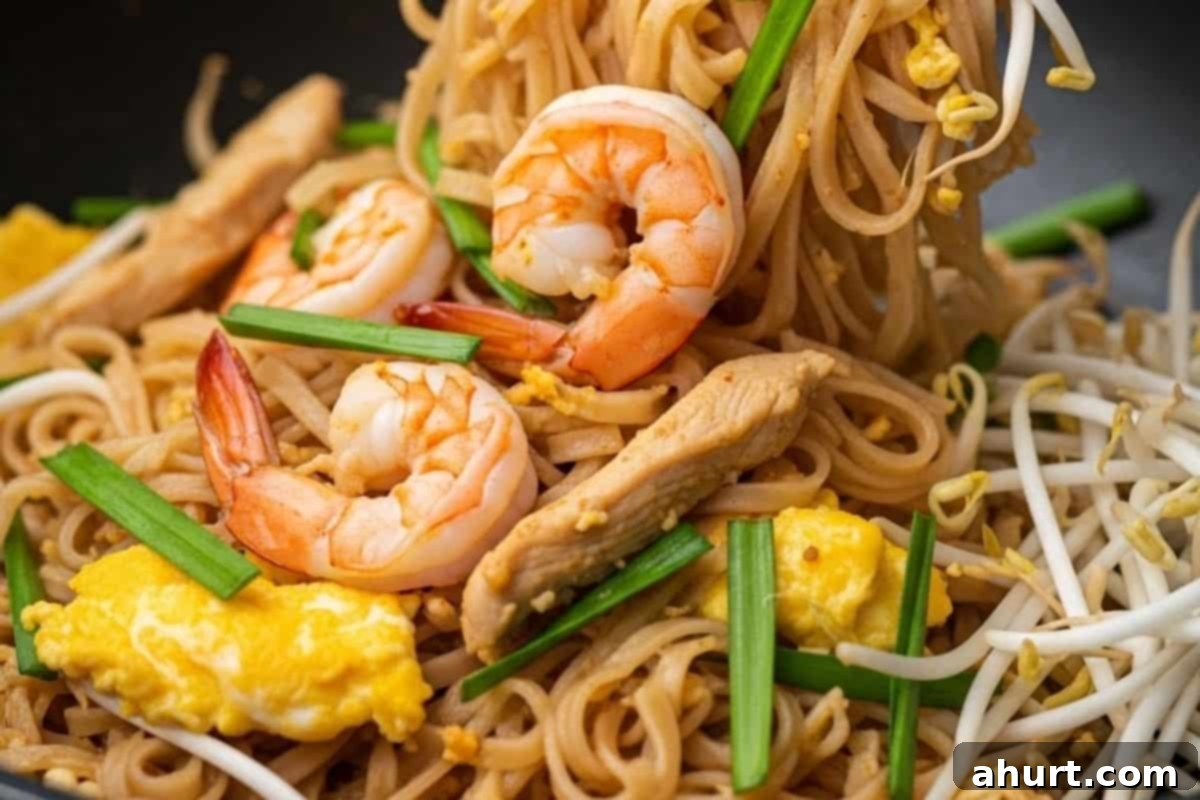
- Finish with Veggies & Proteins: Return the cooked chicken, shrimp, tofu, and egg mixture to the wok. Add the chopped green onions and fresh bean sprouts. Stir-fry for just 1 to 2 minutes, tossing everything together until the vegetables are slightly wilted but still retain their vibrant color and crispness. At this stage, taste your Pad Thai and adjust the seasoning if necessary – perhaps a squeeze of extra lime, a dash of fish sauce, or a pinch more sugar.
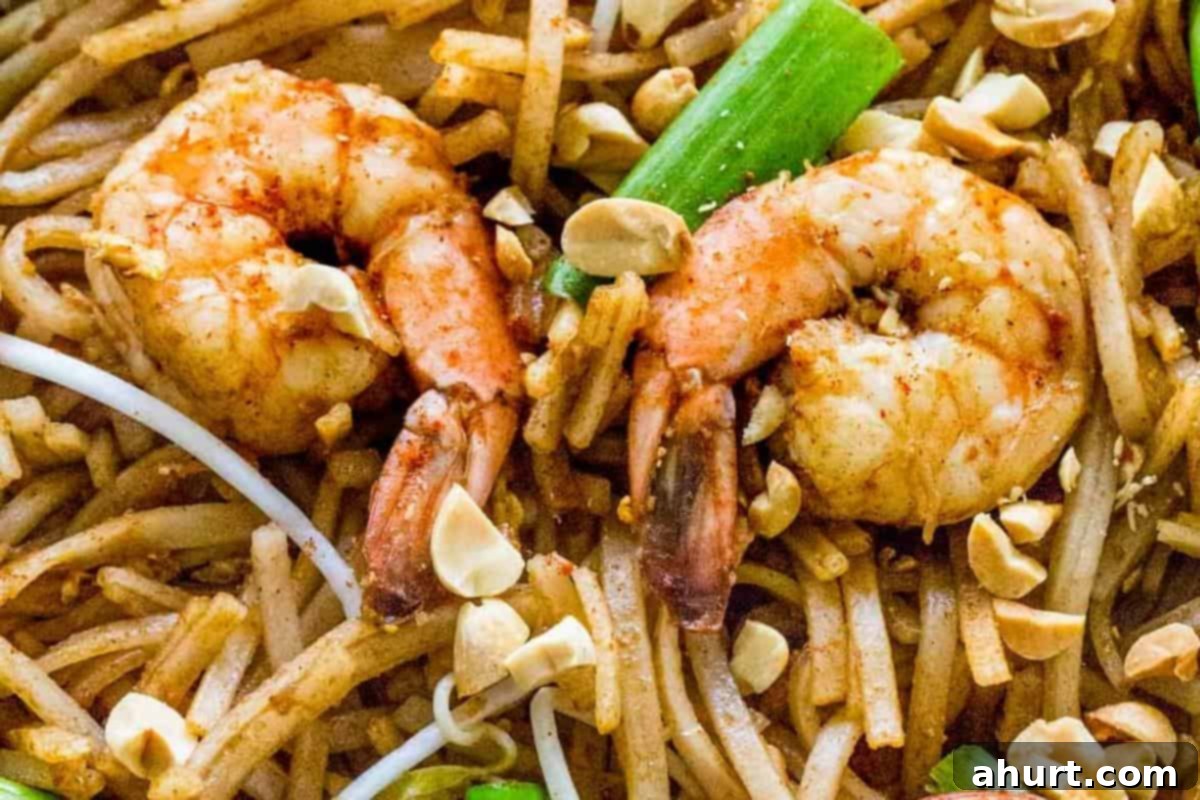
- Serve and Garnish: Immediately divide the hot Pad Thai into individual serving bowls. For the perfect finish, sprinkle generously with chopped roasted peanuts for an extra layer of crunch and nutty flavor. Serve hot with fresh lime wedges on the side, allowing each diner to add an additional hit of brightness to their liking. A sprinkle of chili flakes can also be offered for those who prefer more heat.
Tips for Pad Thai Success:
- Hot Wok is Key: Ensure your wok or skillet is screaming hot before adding oil and ingredients. This high heat is crucial for achieving that characteristic stir-fried flavor and preventing the noodles from becoming sticky.
- Don’t Overcrowd the Pan: Cook proteins in batches if necessary to avoid lowering the pan temperature, which can lead to steaming instead of stir-frying.
- Prep Everything Ahead: Pad Thai comes together quickly, so have all your ingredients chopped, measured, and ready to go before you start cooking. This is known as “mise en place” and is vital for stir-fries.
- Adjust Spice to Your Liking: The recipe has a gentle heat, but feel free to add more chili flakes or sriracha if you prefer a spicier kick. For less spice, omit the paprika or chili entirely.
Serving Your Delicious Pad Thai
Pad Thai is a complete and satisfying meal on its own, offering a perfect balance of protein, carbohydrates, and vegetables. However, a few simple sides can beautifully round out your Thai feast and elevate the dining experience. Consider serving it with Sticky Thai Chicken Wings for an appetizer, or Thai Chicken Satay with a rich peanut sauce to complement the flavors. For a lighter accompaniment, a refreshing Thai Chicken Meatball Salad would offer a delectable flavor explosion without overwhelming the main dish. Don’t forget to offer extra garnishes like fresh cilantro, a side of crushed peanuts, or even a sprinkle of dried chili flakes for those who enjoy a spicier kick.
Frequently Asked Questions About Pad Thai
For authentic Pad Thai, look for flat dried rice noodles, specifically labeled as Pad Thai noodles. Medium-width noodles (around 3-5mm) are ideal because they absorb the sauce wonderfully without becoming overly delicate or breaking apart during stir-frying. Avoid fresh rice noodles for this recipe, as their texture is different and they might become too soft.
The key is proper soaking, not boiling! Soak the dried rice noodles in hot (not boiling) water until they are just tender and pliable, but still have a slight chew to them. They should be flexible but not soft. As soon as they reach this stage (usually 5-10 minutes), drain them immediately and rinse thoroughly with cold water. This stops the cooking process and removes excess starch, preventing them from sticking together and turning mushy during stir-frying.
Traditional Pad Thai typically has a gentle, subtle heat that complements the sweet, sour, and savory flavors, rather than dominating them. Our recipe includes paprika for color and a mild warmth. You can easily adjust the spice level to your preference by adding a pinch of dried chili flakes (often served on the side in Thai restaurants) or a dash of sriracha when serving, or by omitting any chili completely.
Absolutely! To make it vegetarian, simply omit the chicken and shrimp, and increase the amount of tofu and egg. For a vegan version, also omit the egg. You can replace fish sauce with a vegetarian oyster sauce or a combination of soy sauce and mushroom sauce to maintain the umami depth. Add more vegetables like bell peppers, carrots, or broccoli for extra bulk and nutrients.
Leftover Pad Thai can be stored in an airtight container in the refrigerator for up to 2-3 days. To reheat, gently warm it in a wok or skillet over medium heat, adding a splash of water or broth to prevent dryness and help loosen the noodles. You can also microwave it, though stir-frying usually yields better texture.
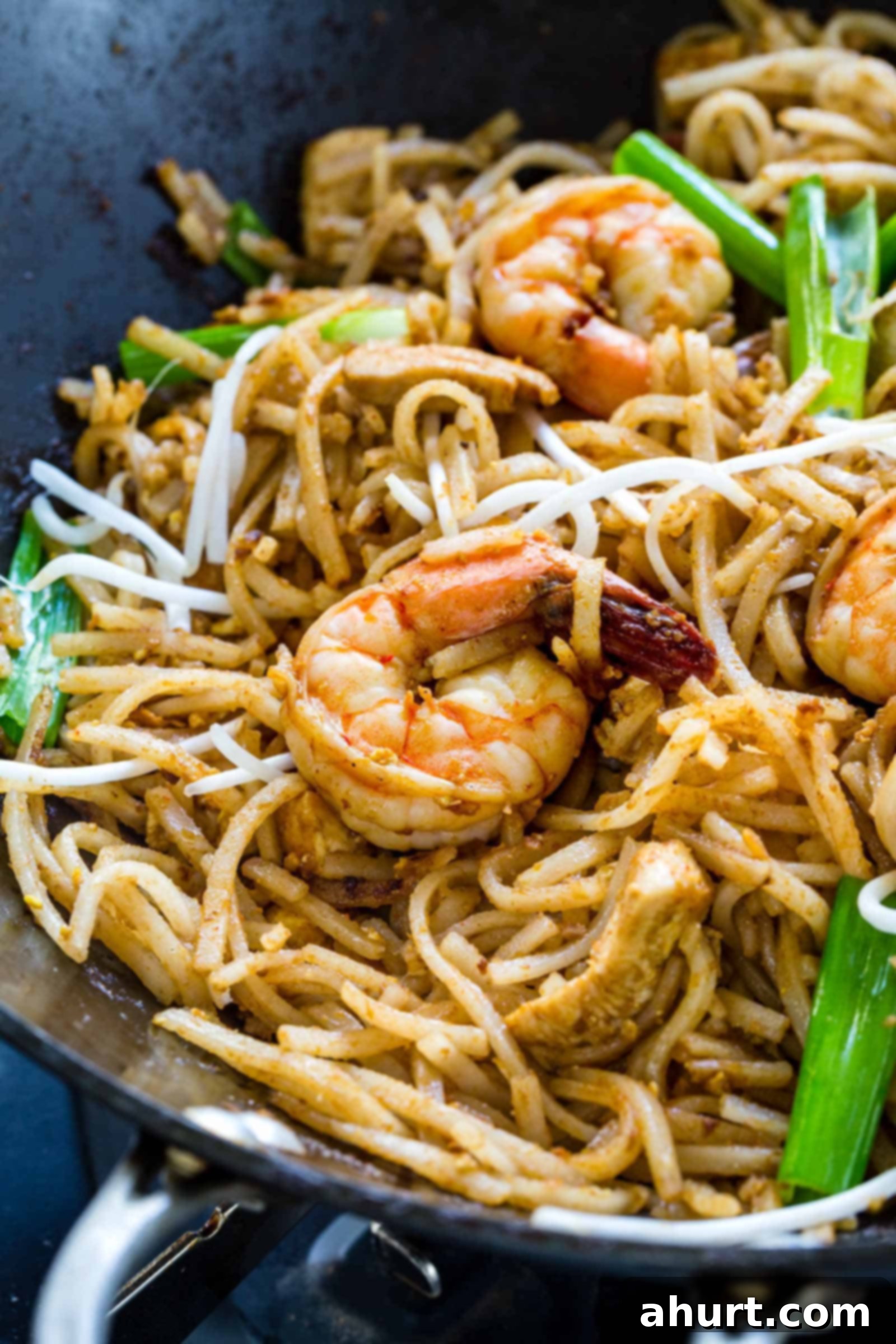
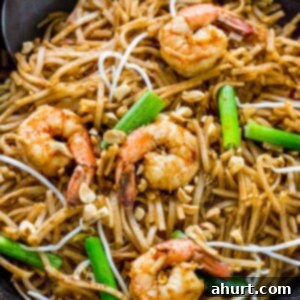
Saved
Pin
Pad Thai
Karina
10 minutes
15 minutes
25 minutes
4
servings
Ingredients
-
14
ounces
dried rice noodles -
2
tablespoons
fish sauce -
2
tablespoons
brown sugar -
4 ½
tablespoons
tamarind paste -
1 ½
teaspoons
lime juice -
1 ½
teaspoons
rice vinegar -
2
tablespoons
vegetable oil -
1
tablespoon
garlic
minced -
1/2
cup
firm tofu
diced -
1
egg
large -
1/2
cup
boneless skinless chicken breasts
sliced -
4
ounces
shrimp
large, peeled and deveined, 16/20 count -
1
teaspoon
paprika -
1/3
cup
green onion
chopped, 2-inches long -
2
tablespoons
unsalted roasted peanuts
chopped -
1/2
cup
bean sprouts
Instructions
-
Heat a large pot of water until it becomes lukewarm (80 to 90°F/ 27 to 32°C), then turn off heat.
-
Add rice noodles and allow to soak until flexible and solid but not completely cooked about 5 to 10 minutes.
-
Drain noodles and rinse with cold water.
-
In a medium-sized bowl whisk together the sauce ingredients; fish sauce, brown sugar, tamarind paste, lime juice, and rice vinegar.
-
Heat a wok or large saute pan over medium-high heat. Add oil, once oil is hot add the garlic and stir for 15 seconds.
-
Stir-fry tofu for 1 minute. Push tofu to the side, add the egg to the pan and allow to set for a few seconds.
-
Add chicken and mix with the runny egg. Stir until they are just cooked through, about 2 minutes, then add the shrimp and cook until just turning pink, about 1 minute.
-
Add soaked noodles, stir to combine and cook for 2 minutes to soften, then pour the sauce onto the noodles, stirring to combine.
-
Turn off the heat, add the paprika and toss until noodles turn slightly red in color. Throw in the green onion and allow to wilt from the heat of the noodles.
-
Transfer noodles to a serving plate, top with bean sprouts, and chopped peanuts.
Notes
Nutrition
Calories:
618
kcal
|
Carbohydrates:
104
g
|
Protein:
20
g
|
Fat:
13
g
|
Saturated Fat:
2
g
|
Polyunsaturated Fat:
6
g
|
Monounsaturated Fat:
4
g
|
Trans Fat:
0.1
g
|
Cholesterol:
99
mg
|
Sodium:
991
mg
|
Potassium:
439
mg
|
Fiber:
4
g
|
Sugar:
14
g
|
Vitamin A:
405
IU
|
Vitamin C:
5
mg
|
Calcium:
122
mg
|
Iron:
3
mg
Nutrition information is automatically calculated, so should only be used as an approximation.
Tried this? Leave a comment below!
